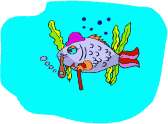 |
Fishing Stories from Ned Kehde |
|
Fishing Reports Reader's Nook Angler's Academy Club Corner Tournament Trail Success Stories Kansas Angler Info Angler Links |
Submitted by Ned Kehde - Nov. 9, 2000 Traditionally the white bass and one of their favorite prey, the gizzard shad, migrate to and eventually above the Highway 237 bridge once the water temperature dips into the 60s. The fishing can turn white hot when the water temperature reaches the upper 50s. And as long as the white bass are caught and then quickly released, anglers can catch scads of them for weeks on end. Last autumn, however, the white bass fishing never materialized. The white bass at the big reservoirs around Lawrence were ailing, and, in fact, many of them died. On top of that, the white bass had been drastically overharvested during the last half of the 1990s. Consequently, the fishing at Perry turned so rotten that even the area's finest white bass anglers failed to garner a bite when plying all Perry's best autumn lairs. So last year Roger spent his day afloat in Kansas at La Cygne Lake. But upon learning that Perry's white bass had made a minor resurgence this summer and fall, Roger left his northern Ozarks haunts to spend a day at Perry in pursuit of his favorite quarry. At the age of 29, Roger is a consummate white bass fisherman. He began pursuing these silver demons at the age of six, fishing at his father's side on the 109,000 acres of the flooded Osage River that constitutes the Lake of the Ozarks and Truman Lake. And his father picked up many of his white bass tactics from Guido Hibdon of Gravois Mills, Mo, who is the world's finest multispecies angler. During the past quarter of a century, Roger has mastered a variety of methods for alluring white bass. He can entice them on the surface with topwater lures, on the bottom in 25 to 30 feet of water with two-ounce spoons and everywhere in-between with a variety of methods and lures. But his forte is using a either lightweight marabou jig or a Worden's Rooster Tail on medium-action spinning tackle in shallow water near the shoreline On this outing, the white bass were heavily congregated in shallow water along a riprap of a causeway, and not another place on the lake entertained a significant concentration of Roger's quarry. Of course, the white bass that gamboled about the shallow rocks of the causeway had a difficult time resisting Roger's deftly retrieved marabou jig. The difference between Perry and the Ozarks' white bass, according to Roger, is that Perry's fish are less pelagic and tend to congregate for long spells at a small area, which makes them easy to catch. But to be able to keep catching them day after day, Perry's anglers have to release 95 percent or more of the white bass they catch. When Roger launched the boat at 9 a.m., Rock Creek's nearly glass-smooth surface was graced with a flotilla of terns, gulls, coots and pelicans. The October sun shown brightly, and only infrequently did a cumulus cloud impede its rays. By 3 p.m. the sun heated the lake's surface temperature to 64 degrees. And throughout the day, the low-slung hills surrounding the lake glowed with an array of amber and scarlet leaves. It was a quintessential autumn day to be afloat, and by the time that Roger made his last cast, he and his uncle had caught and released 112 nice-sized white bass. |
|
Kansas Angler Online Sponsor  |
Copyright 2000 by The Kansas Angler - P.O. Box 12261 - Wichita, KS 67211 - Phone 316-265-5551 Questions or problems with this website should be directed the link above. This Page Last Updated on date shown at top of page. |

